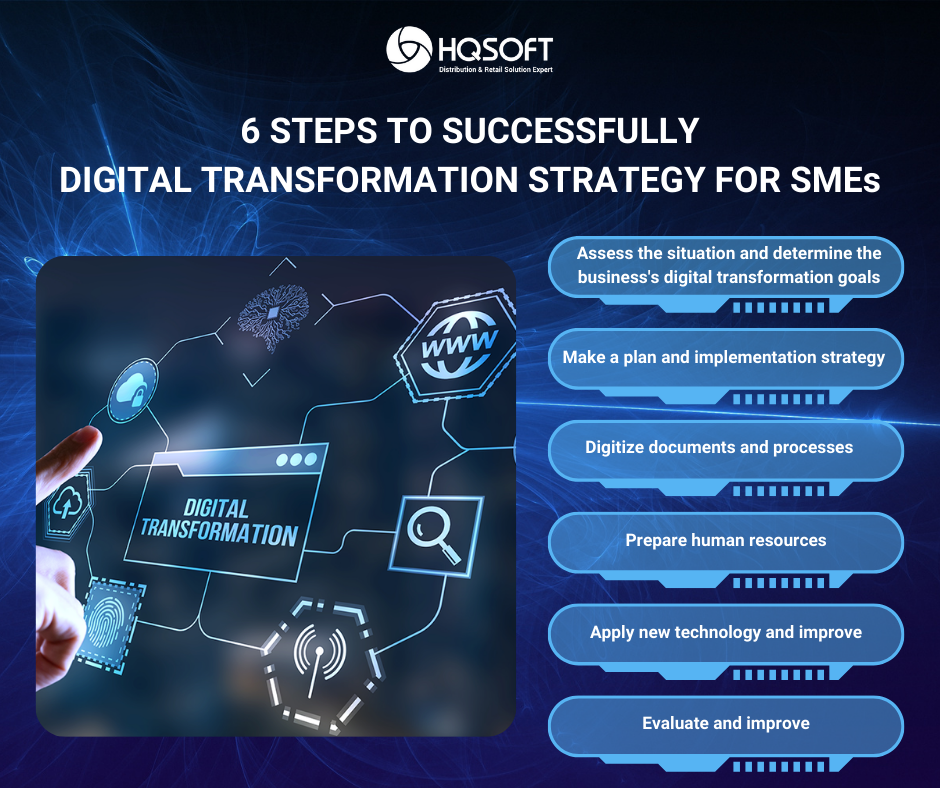In the context of the strong development of the 4.0 Industrial Revolution, digital transformation is one of the factors that helps businesses face new challenges, increase business efficiency, and enhance competitive advantage. So how can SMEs carry out digital transformation successfully? Please refer to the content below with HQSOFT!
Digital transformation of small and medium enterprises is the integration of digital technology into the organization’s business process to increase operational efficiency, enhance customer experience, and generate profits competitive position in the market.
For large corporations or companies with technology roots, digital transformation can be a lighter ‘mission’. However for small and medium enterprises, although the digital transformation process is often easier, the application is fast, and the requirements are less complex, but there are limitations in human resources.
Digital transformation will help SMEs expand their markets, effectively deploy distribution channels, simplify deployment processes, and focus on the quality of customer care services. In particular, digitalization contributes to lower environmental emissions instead of storing records.

Step 1: Situation assessment and determine the business’s digital transformation goals
First, the executive board needs to evaluate the actual state of their businesses such as the number of employees, work process, financial situation, and corporate culture. This will determine whether or not to apply digital transformation using this evaluation and assessment. The more detailed and clear criteria will reveal the level of readiness for conversion.
In the evaluation sheet, businesses must address the following questions:
What are the shortcomings in current business and operational processes?
Which processes and locations can apply technology?
Does the business have the ability to adapt? How adaptable is the business after digital transformation?
The advantages and difficulties of businesses when applying digital transformation
After answering the above questions, it is important to determine the goals to be achieved when digitally transforming. These goals must be feasible and based on the current situation of the business. The more specific and clear the goal will help digital transformation take place quickly and achieve the expected results.
Step 2: Plan development and strategy implementation
After assessing the situation and determining digital transformation goals, businesses need to develop a well-defined plan. The executive board must outline the work to be done, implementation time, predicted results, etc. The more detailed and clear the plan is, the easier it is to follow and implement. This is an essential preparation for big changes like digital transformation.
Next is to determine the strategy to best achieve the set goals. A smart and correct strategy will help businesses transform digitally easily and quickly.
Step 3: The digitization documents and processes
This is the most basic step in the digital transformation process in businesses. All paper documents need to be converted into digital format. This brings many benefits to businesses, such as helping businesses easily manage and search as well as increasing document security.
Operational processes within the company should also gradually be digitalized so that digital transformation is optimized effectively. Digitizing the process saves time and solves problems, cuts personnel costs, and boosts work processing productivity,…
Step 4: Preparation of human resources
Digital transformation is not solely about technology, but the human factor is also very important. To perform a successful digital transformation, businesses need to have high-quality human resources, solid expertise, and an adaptable mindset are essential.
In addition, the working environment and working culture of the business must also be suitable, encouraging innovation and trend awareness, and facilitating the adoption of digital transformation.
Step 5: Application of new technology
Small and medium-sized businesses are currently facing challenges in applying technology to serve the digital transformation process. Therefore, the application of new technology must be carefully prepared and implemented. Choosing the appropriate technology will help businesses experience many advantages in the digital transformation process.
Step 6: Evaluation and improvement
After implementing the above 5 steps, businesses need to review and re-evaluate the process and results.
This assessment must address the following questions:
Is the ongoing digital transformation bringing any changes?
How did the results compare to the predefined goals?
What adjustments are necessary to enhance the quality of the digital transformation process?
From there, businesses will outline what needs to be done to improve the quality of digital transformation.
As an expert in the field of technology, HQSOFT understands the concerns and efforts of SME businesses in the process of digital transformation. We hope that with the above insights, SME businesses will break down all barriers on the path to digital transformation and improve business efficiency.
.
 Từ khóa:
Từ khóa:
bài viết liên quan
Bài viết nổi bật